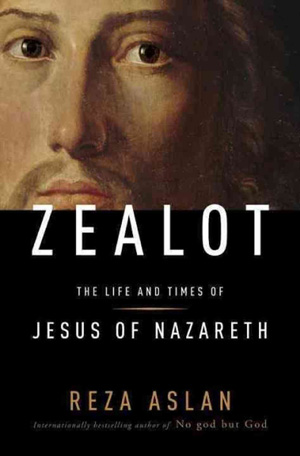
This article is from the Spring 2014 issue of New Humanist magazine. You can subscribe here.
Reza Aslan was the author granted a priceless publicity gift by Fox News in the course of promoting this book. Lauren Green, Fox’s Chief Religion Correspondent, subjected Aslan to an inquisition inane and fatuous even by Fox’s lofty standards of inanity and fatuity, focusing not on Zealot itself but on Aslan’s suitability as its author. Green was obsessed with the idea that Aslan, a Muslim religious scholar, had summoned the temerity to write about the founder of Christianity – a heresy she compared, at one especially weird point, to “a Democrat writing a book about why Reagan wasn’t a good Republican” (which would, of course, be a perfectly reasonable thing for a Democrat to do). Aslan’s implacable composure and bemused courtesy in the face of Green’s vapid blathering sent the clip viral, and Zealot to the top of the bestseller charts. This seemed fitting reward for such a textbook observation of the injunction to “resist not evil: but whosoever shall smite thee on thy right cheek, turn to him the other also.”
Amusing though this karmic payoff was, it left open the question of whether Zealot deserves that much attention on its own merits. Or, indeed, whether any attempt at this sort of biography does – a depiction of Jesus the man, rather than Jesus the Christ. As Aslan admits with breezy candour early on, verifiable facts about Jesus’s life are thin on the ground. We can be pretty sure he existed: “Jesus, the one they call messiah”, is mentioned by the first-century Jewish historian Flavius Josephus in a context that appears to assume the reader’s knowledge of him. And we can be reasonably confident about the grisly means of Jesus’s demise – his arrest and execution are noted by Tacitus and Pliny the Younger. Beyond that, we can be certain of very little. The Gospels cannot, ironically, be regarded as gospel – as Aslan correctly notes, they were composed (at the earliest) decades after the events they purport to record, and are collections of fable and myth, often muddled and contradictory at that, rather than eyewitness reportage.
If little is certain about Jesus’s life, rather more is known about his times, which Aslan evokes with commendable diligence. Zealot becomes, in part, a handy primer of first-century Middle Eastern history. As Aslan tells it, the Holy Land of this period was a seething snakepit of sectarian rivalries, bedevilled by political intrigue and incomprehensible bloodshed, with religious piety often deployed as a cover for tribal loathing (how times have changed, etc). The region was also plagued by preachers of varying plausibility, of whom Jesus was but one – Aslan writes that most of his fellow Jews of the time would have seen him as “neither messiah nor king, just another travelling miracle worker and professional exorcist roaming through Galilee performing tricks”.
Which is not to suggest that Zealot is an act of iconoclasm. Aslan clearly admires Jesus, and, at the risk of inflaming the wrath of Fox News, his freedom from any obligation to buy the son-of-God stuff permits some fresh and refreshing contemplation. Aslan makes a persuasive case against several familiar myths. It is far more likely, he argues, that Jesus was born in Nazareth than Bethlehem – this detail was probably fudged in later years in the service of the legend of Christ, and at any rate the census called by the Syrian governor Quirinius, the ostensible reason for Joseph and Mary’s journey to the manger, happened ten years after Jesus was (probably) born, and didn’t include Galilee, where he lived. The flight into Egypt to escape King Herod’s massacre of the innocents is also briskly dispatched with the observation that not a single known chronicler of the period made any note of what would have been, even for the uncompromising Herod, a fairly eye-catching royal decree.
At its core, Zealot is a gentle – if not altogether original – dispute with the modern notion of Jesus, whom we are generally encouraged to perceive as a forgiving and boundlessly tolerant sort. Zealot, as the title hints, attempts to portray an angry, somewhat self-righteous young nationalist revolutionary, descended from a lineage of ornery Galilean hillbillies, who was not above a degree of ass-kicking and name-taking when he thought it necessary. Aslan chooses as his epigraph Matthew 10:34 (“Do not think that I have come to bring peace on Earth. I have not come to bring peace, but the sword.”) He argues that the key to Jesus’s character is found not in any of his benign miracles, but in his overturning of the stalls of the temple money-lenders. It’s a depiction undermined slightly by the fact that – as Aslan himself demonstrates – Jesus lived in a place and at a time when it was barely thought bad manners to slaughter entire peoples, raze their villages and till the land with salt in order to make a point. In his original context, Jesus may have been more of a hippy than Aslan wishes to admit: sixteen chapters of Matthew later, of course, he’s all “Put up again thy sword into his place; for all they that take the sword shall perish with the sword.”
This is a minor irritation of Zealot throughout – that Aslan is noticeably accommodating of those sections of the Gospels that suit his thesis, and rather more sceptical about those that inconvenience it. But such has been the one constant of every telling of this story: everybody makes Jesus, like everybody makes God, in their own image.
Reza Aslan's Zealot: the Life and Times of Jesus of Nazareth is published by Westbourne Press

